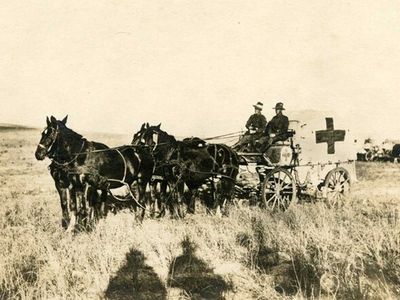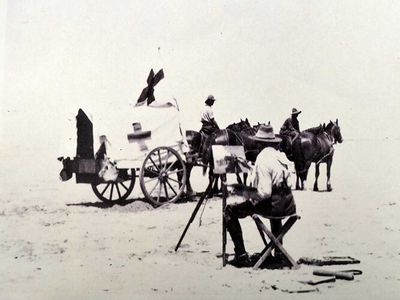“Major Avery, among many other Old Boys, holds a special place on the TGS Old Boys’ Wall of Achievement for his role in inventing the “Rapid Transit Ambulance” that was a key part of the Australian Light Horse Brigade.”

On ANZAC Day, we come together to reflect on the importance of service and sacrifice.
Toowoomba Grammar School would like to acknowledge our admiration for the loyalty, service and bravery exhibited by TGS Old Boys who so valiantly served. We are all the beneficiaries of their sacrifice, and their selfless actions continue to inspire a spirit of service amongst our current students.
Today we focus on the contribution of one TGS Old Boy who made a significant contribution to World War I. Here is some of the incredible story of Major Avery, DSO and if you visit the School Museum and Archives you can see a display in his honour.
Much of this history has been captured through countless hours of dedication and devotion by current TGS museum volunteer and former TGS staff member, Mrs Ann Hallam who managed the School’s Cadet Unit from 2006-2019.
Major Avery DSO, inventor of the WWI “Rapid Transit Galloping Ambulance”
Distinguished TGS Old Boy, Leonard Grimes (1880-1885) was born in Queensland in 1869 and died in 1953. Grimes attended the School in the days of Sir Harry Chauvel and Sir Littleton Groom and while at TGS was known as Leonard Avery Grimes.
After his School days he went on to Wadham College, Oxford, where he graduated with a medicine degree. He later changed his name to Conrad Avery and after some years as a hospital physician and surgeon, Avery enlisted with the British Army and joined the Suffolk Imperial Yeomanry. He was later promoted to Major and joined the Royal Army Medical Corps. During World War I he was enlisted with the Royal Westminster Dragoons and served in Palestine, Egypt and Syria.
Major Avery, among many other Old Boys, holds a special place on the TGS Old Boys’ Wall of Achievement for his role in inventing the “Rapid Transit Ambulance” that was a key part of the Australian Light Horse Brigade.
Light Horse Field Ambulance
The Light Horse units were mounted infantry with efficient mobile medical support to the wounded and sick soldiers of an Australian Light Horse Brigade. The Field Ambulance ensured the removal of the wounded from the front line to the advanced dressing station where there were surgical and resting tents.
These sand carts had two wheels with tyres that were wide enough to stop the cart digging into soft sand and could carry two or three stretchers. In heavy sand four horses were necessary to pull the cart, and the cart had to be steered by a rider on one of the lead horses.

Australian Light Horseman
The 2nd Light Horse Field Ambulance was formed in Brisbane with much of the unit coming from Queensland.
More than 15 TGS Old Boys enlisted with the Second Light Horse Brigade, two of whom died at Gallipoli: Major Dugald Maxwell Lockwood Graham and Trooper Gordon Holmes Robertson.
During the World War I, George W. Lambert (1873-1930) served Australia as an Official War Artist attached to the ANZAC Mounted Division. He spent two terms in service, the first with the Light Horse in Palestine, and the second in Gallipoli and Egypt before his military contract discharge.
As a result of Lambert’s service during World War I, he was offered a variety of commissions to paint scenes from significant war time events, including an activity of the 2nd Australian Light Horse Field Ambulance, Walk (An Incident at Romani).
The Battle of Romani was the last ground attack on the Suez Canal at the beginning of the Sinai and Palestine Campaign. The battle was fought from 3 to 5 August 1916 near the Egyptian town of Romani.
The completed painting was to be given to the Queensland (National) Art Gallery by the Light Horse in memory of their fallen comrades.
The Rapid Transit Ambulance
Major Avery describes his vision for a new galloping ambulance, known as “The Rapid Transit Ambulance”.
This ambulance was designed with a view to filling the want of stretcher bearers with mounted troops. The endeavor has been to construct a light strong carriage easily adjustable to any mounted horse and capable of keeping up with cavalry through any sort of country. As will be seen from the accompanying illustration, the ambulance is a two-wheeled contrivance.
The body consists of a platform fixed to a crank axle by long springs between 46-in. wheels. This platform is 2 ft. 3 in. from the ground and is arranged to carry an ordinary service stretcher. The forepart consists of a pair of short shafts which are attached to the body by an arrangement of springs adapted to prevent the side-to-side motion caused by the action of the horse. The shafts reach as far forward as the saddle flaps, where they are held in position by a girth strap, breastplate, and belly-band.
The body is covered by a canvas hood. The weight is about 3 cwt. Length overall, 12 ft. Track, 4ft. 1 in. Surgical dressings, splints, water-bottle, &c., are carried. It is quite easy for the driver, having placed a wounded or helpless man in a stretcher, to transfer him from the ground to the platform of the carriage single-handed.
This ambulance has been on duty with the Suffolk, Sussex, Surrey and Middlesex Imperial Yeomanry during their respective training, and with the Wiltshire Yeomanry through the recent maneuvers. It is a very comfortable conveyance and has proved capable of negotiating with almost any country.
Walk (An Incident at Romani)
The incident to which Lambert’s painting refers occurred during the Battle of Romani on 4 August 1916. The 2nd Light Horse Field Ambulance had deployed two sand-carts to an exposed part of the line to retrieve some seriously wounded men. Upon its return journey the Field Ambulance envoy came under Turkish fire and its panicked horses started to bolt.
Tragedy was averted when the corporal signaled ‘Walk’ and galloped to the front of the party to steady the teams. After the horses had been calmed and resumed their pace, the enemy apparently recognised the Ambulance’s mission and averted their fire. As a result of their bravery and composure during the incident the corporal and drivers were awarded Military Medals.

To enable Lambert to make sketches of the event that was already three years in the past, it was re-enacted at Kantara, Egypt in 1919. Photographs were taken of Lambert at work sketching this re-enactment. The completed painting portrays the moment when the corporal signals ‘Walk’ whilst rushing to the front of the group to steady the bolting teams.
Remembrance Day
Remembrance Day marks the anniversary of the Armistice which ended the First World War, signed at 11:00am on 11 November 1918. We still remember those who have given their lives in conflict before and since, by taking a minute to stop, be silent and remember the war that was to end all wars.
Latest Blog
Facilitating Respect
Recently the 2022 TGS Prefect group spoke at the Headmaster’s Assembly about respecting individuality. But what does this mean? The foundations for a successful relationship with peers, family, co-workers, and others is framed and supported by a two-way street of respect. However, for this two-way street to be functional it is important to know that respect cannot be demanded, it can only be earned. Toowoomba Grammar School is no different and respect is nurtured in various forms such as in the…
The Benefits of Early Learning at TGS
Making a decision about our children’s education can be difficult; especially when there are so many options available. Once upon a time parents simply sent their children to the school that was a walkable distance from home. Much research has evolved since the early 1900s about what is best for our children to foster a love of learning and feel confident and safe in the classroom. Here at Toowoomba Grammar School, we take this very seriously. Pastoral care comes before anything else; we see…
Outside of the Text Book
“The limits of my language mean the limits of my world.” — Ludwig Wittgenstein There is no denying that learning a foreign language can sometimes be a challenging experience, particularly with limited opportunity to practise outside the classroom. However, learning a language is a skill that will add to many facets of your life, often without you even realising, and as part of a well-rounded education, the value of language learning cannot be underestimated. "A different language is a…
TGS Academic Enrichment Program for Boarders
Toowoomba Grammar School provides an inspiring and broad curriculum for boys, delivered by dedicated educators who understand how to engage boys in their learning. Our staff go above and beyond in providing an outstanding education and support network for our boys. They are regularly available to answer questions, assist with homework and assignments and provide academic support for all our students. This is particularly so for our boarders, thanks to our Academic Enrichment Program (AEP). All…
Teacher as a Student
As a teacher at Toowoomba Grammar School, I teach mathematics and business studies, and manage the GPS Chess team. Prior to teaching, I worked as a financial analyst. Recently I have completed a master's degree in science at the University of Southern Queensland. My study was focused exclusively on data science, and I have become an expert in the management of big data with a specialisation in modelling and forecasting using machine learning techniques. The motivation for this study was…
Developing Healthy Relationships
Healthy relationships are extremely important for the development of mental health in our youth. When you spend time with people you care about, who care about you, this can help you feel connected and supported. This term is one of the largest in regard to boys participating in activities and sports ranging from field, to court, to thought. This is in addition to music and drama programs. At Toowoomba Grammar School, we believe this allows for plenty of opportunity to develop the ability to…
Striving for the Best
Director of Volleyball, Mr Eric Smith has spent the past 20 years at Toowoomba Grammar School not only shaping the minds of the young men in his science classroom but also working tirelessly on improving his capacity to coach volleyball to the highest level. Starting at the School in 2003, Eric quickly rediscovered his passion for volleyball, something he had not experienced since playing for Ipswich Grammar School during the ‘90s. “I felt completely at home back on the volleyball court and…
When it comes to Music, Variety is the Spice of Life
In the Queensland Curriculum, the content of the music syllabus includes the study of the people, places and cultures involved in musical creation and performance. As our country becomes increasingly diverse, it is important for students in every school setting to study a wide variety of musical styles, cultures and genres. The Toowoomba Grammar School Music program of 2022 embraces this holistic approach to the study of music, encouraging teachers and students to explore a variety of musical…
Successful Decision Making - Subject Selections
Term 3 tends to be an important time for students making decisions, and for some, possibly the first time they have really had the opportunity to make a decision that could impact the course of their future. Year 8 students are taking control of their academic program for the first time, being able to select their electives for Year 9. For most, these decisions are mainly about getting the opportunity to pursue subjects which interest them and the joy of not taking some subjects which really do…